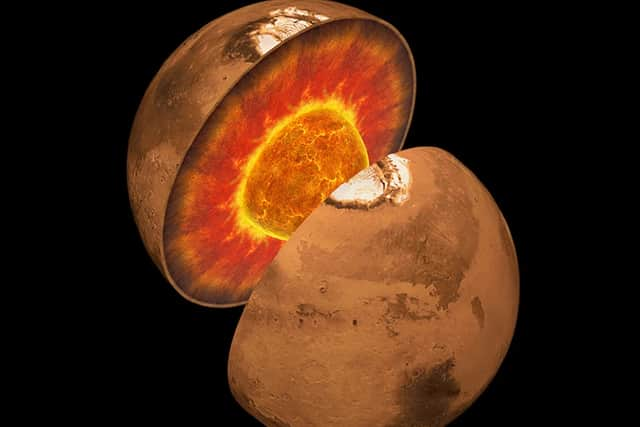Mars: researchers discover a surprise layer of molten rock underneath the surface
and live on Freeview channel 276
Scientists have discovered a new layer in Mars after analysing seismic waves generated when Mars was hit by a meteorite impact suggests there is an unknown layer of molten rock surrounding a liquid metallic core.
The seismic waves were picked up by Nasa’s InSight lander - which was sent to Mars to better understand its seismic activity. The lander watches how the waves travel around and can be used to get a picture of the anatomy of the planet. NASA retired InSight in 2022 after four years of operations.
Advertisement
Hide AdAdvertisement
Hide AdThe new layer is smaller and denser than previously estimated. The waves, generated by quakes, including those caused by meteorite impacts - vary in speed and shape when travelling through different material inside a planet. Data from InSight’s seismometer instrument has enabled the planet’s internal structure to come into focus.


The meteorite impact in the Martian highland region of Tempe Terra called Elysium Planitia on 18 September 2021, triggered a magnitude 4.2 quake and left a crater about 425 feet (130 meters) wide.
Planetary scientist Amir Khan of ETH Zurich in Switzerland, lead author of one of two scientific papers said: “The importance of the far side impact was to produce seismic waves that traversed the deep interior of the planet, including the core. Previously, we had not observed any seismic waves that had transited the core. We had only seen reflections from the top of the core." The new findings published in the journal Nature.
The behaviour of the waves indicates previous assessments of the Martian interior were missing something - the presence of a molten silicate layer about 90 miles (150 km) thick surrounding the core which sits on the interior portion of the planet called the mantle.
Advertisement
Hide AdAdvertisement
Hide AdRecalculating the core, the researchers found it has a diameter of about 2,080 miles (3,350 km), with a volume about 30% smaller than previously thought.
The mantle, a rocky layer sandwiched between the planet’s outermost crust and core, extends about 1,055 miles (1,700 km) below the surface. Unlike Mars, Earth has no molten layer around its core. One of the two studies published on Wednesday indicates this layer is fully molten, with the other indicating that most of it is fully molten, with the top portion partially molten.
“The molten and partially molten layer is essentially composed of silicates (rock-forming minerals) that are enriched in iron and in radioactive heat-producing elements compared to the overlying solid mantle,” said Henri Samuel, a planetary scientist with the French national research organization CNRS working at Institut de Physique du Globe de Paris and lead author of the second study.
The Martian core largely iron and nickel, but also has some lighter elements such as sulfur, oxygen, carbon and hydrogen. These lighter elements make up about 9-15% of the core‘s composition by weight, lower than previously estimated.
Advertisement
Hide AdAdvertisement
Hide Ad“This amount of light elements is not unlike that of the Earth’s core, which is estimated to be around 10%,” Khan said.
Mars has a diameter of about 4,220 miles (6,791 km), compared to Earth’s diameter of about 7,926 miles (12,755 km) - which is almost seven times larger in total volume.
"We have learned a lot about Mars by studying the unique seismic record provided by the InSight mission,” Samuel said. “Planets are rich and complex systems because they are a place where many different types of processes coexist and act on various spatial and temporal scales, and Mars is no exception.”
Comment Guidelines
National World encourages reader discussion on our stories. User feedback, insights and back-and-forth exchanges add a rich layer of context to reporting. Please review our Community Guidelines before commenting.
